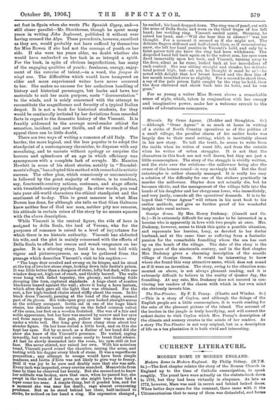C URRENT LITERATURE.
MODERN ROME IN MODERN ENGLAND.
Modern Rome in Modern England. By Philip Sidney. (R.T.S. 5s.)—The first chapter relates the story of the Roman Church in England up to the time of Catholic emancipation, to speak roughly. The penal laws were actually on the statute-book down to 1778, but they had been virtually in abeyance. As late as 1772, however, Mass was said in secret and behind locked doors. When better days came for the remnant, there came with it the Ultramontanism that to many of them was distasteful, and forms of devotion, especially in the cultus of the Virgin, that were equally unwelcome. In subsequent chapters the history of English Romanism is traced down to the present day. The names of Errington, Wiseman, Faber, and Manning, the last two Hibernia Hiberniores, are connected with the events of the greatest importance. They suggest the fact that under the smooth surface of an apparent harmony storms of no small violence sometimes rage. There is, of course, the age-long conflict between "Gallicanism," if the term may be so extended in use, and Ultramontanism, and there are also the mutual jealousies of Seculars and Regulars. Cardinal Wiseman's com- plaints of the Regulars, whom he himself did much to introduce, are very striking. They are, indeed, bound to be a trouble; nearly all the extravagances of Roman devotion come from the cloister. It was an Abbot who wrote the famous sentence in which the cu/tus of Mary reached its most shocking development,—"pul- chritudine sua Deum allexit e caelo." One of the interesting things in the book is the roll of converts from Anglicanism. Mr. Sidney does not give what would have been instructive,—a com- plete list of English clergy who have made this change.















































 Previous page
Previous page